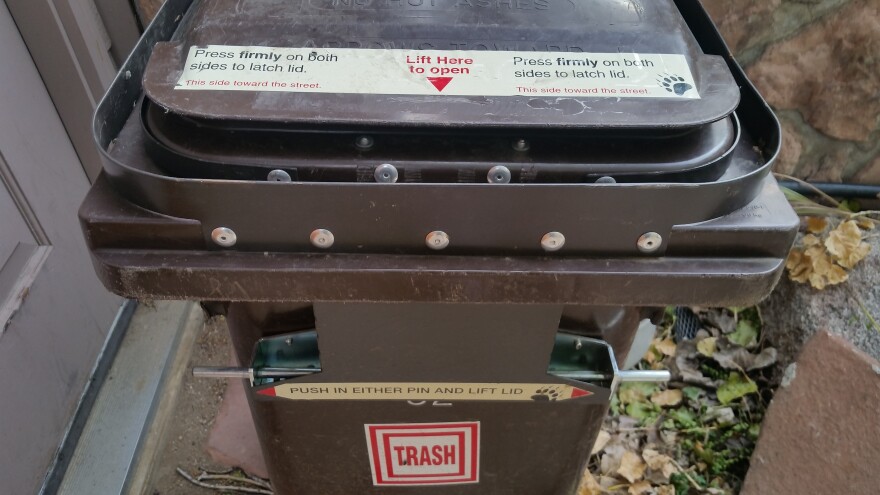Colorado is home to more than 19,000 black bears, all focused on consuming thousands of pounds of calories a day as they prepare for their long winter's sleep. That's bringing them into more conflicts with humans, especially as they explore neighborhoods for trash and ripe fruit fallen from trees. Recently, bears been seen going from car to car in Aspen, trying door handles. They also broke into an Estes Park restaurant and raided the refrigerator.
According to Colorado Parks and Wildlife Spokeswoman Lauren Truitt, her agency often logs as many as 100 bear calls a day every October.
“Those can be from, 'Hey, there's a bear walking down my street,'” she explained, “to a more dangerous situation where we have to, in some cases, euthanize a bear.”
More than 130 of the animals have been put to death by state and federal agencies and landowners in Colorado this year. It isn't a record number, but higher than average. Bears are euthanized when they're considered 'aggressive,' which Pruitt defines as charging people, entering a house, or returning to an area from which they've been previously removed.
Part of the reason so many bears have been put down this year is because a key food source is missing.
“In some areas of the state, we're looking at food failures,” Pruitt said. “We had a late freeze in June, which we typically don't see. What that did is it really hindered the acorn production this fall.”
Bears are omnivores and will eat almost anything, especially in their pre-hibernation rush of 20,000 calories a day. They prefer berries, grasses and acorns, with a little protein on the side in the form of insects and newborn deer and elk.
But when one of those food sources is taken away, they'll seek out other forms of food to make up for the loss. If they live close to humans, that often means discarded kitchen scraps, usually found in an unsecured trash can.

“Because they have such high dietary needs,” said Pruitt, “human trash offers very easy access to a high-calorie meal. If you remember Winnie the Pooh and his love for honey, that's kind of where our bears are this time of year.”
Their insatiable appetite often brings them into contact with humans, so they lose their natural fear of us. But it can also dangerous for them. They can cut their tongues in their zeal to lick plastics, cans, and glass. They can also accidentally ingest cardboard containers, which can clog their digestive systems and starve them.
Wildlife biologists have also found that access to trash shortens their hibernation period, simply because they're enjoying the smorgasbord too much to sleep.
“Most bears have a natural rhythm where they're going into hibernation in November, and they come out of hibernation the first part of April,” explained Truitt. “Bears that have easy access to trash are going into hibernation later and later.”
This throws off their natural body rhythm, and can be detrimental to cubs, who are born in the den during hibernation.
Truitt makes it clear that human behavior has a direct effect on bear behavior. CPW works with local jurisdictions and bear advocacy organizations to take steps to make neighborhoods unappealing to bears.
Brenda Lee runs the Boulder Bear Coalition. She works with residents and businesses to become what’s called 'bear aware,' It's about giving the animals a dose of negative reinforcement: Encouraging property owners to use bear-resistant trash cans, making sure downed fruit is quickly removed, and installing electrified fencing to protect livestock and beehives.
“Our goal is to keep bears from coming into town,” Lee said. “And also, for the occasional bear that comes through town, to make sure it's not too comfortable so the bear does not want to stay. We don't want them comfortable around us.”
Lee feels the Boulder Bear Coalition is having an impact reducing human and bear conflicts, partially by educating citizens on how to make human territory unappealing, and even scary, to bears. She's received calls from around the U.S. from people wanting to know how to emulate the success of her organization.

“We can be leaders in showing that if we're smart and taking the right steps, we're protecting bears in the future,” said Lee, “and we don't have to be relying on wildlife officers to come in and deal with a crisis.”
A bear-resistant trash can should be almost impossible for a hungry ursine to breach. It should even be hard for a human to get into.
Boulder Canyon resident Zigy Kaluzny demonstrated this recently when he had to set a trash bag down, just to open the lid.
“It's always a two-hand operation,” said Kaluzny as he dropped the bag into the can and firmly shut it.
He admitted that he only recently got a bear-resistant can. He used to keep his trash can locked in the garage, where it could get pretty stinky.
“I don't know why I put it off for so long,” he said.
Kaluzny has had several interactions with bears during his time in the canyon, including recently, when he glanced up and found himself locking eyes with a large adult.
“The bear was about 20 feet from the back door,” recalls Kaluzny. “It reared up from all four paws just slightly and went 'Huh! Huh!' I huffed back at it, and it wandered off.”
He's also heard bears wrestling with his trash can at night, trying to get at leftovers. They're never successful, and, after a few minutes, give up and move on.
For more information: Colorado Parks and Wildlife's "Bear Aware" resources; the Estes Park Bear Education Task Force.





